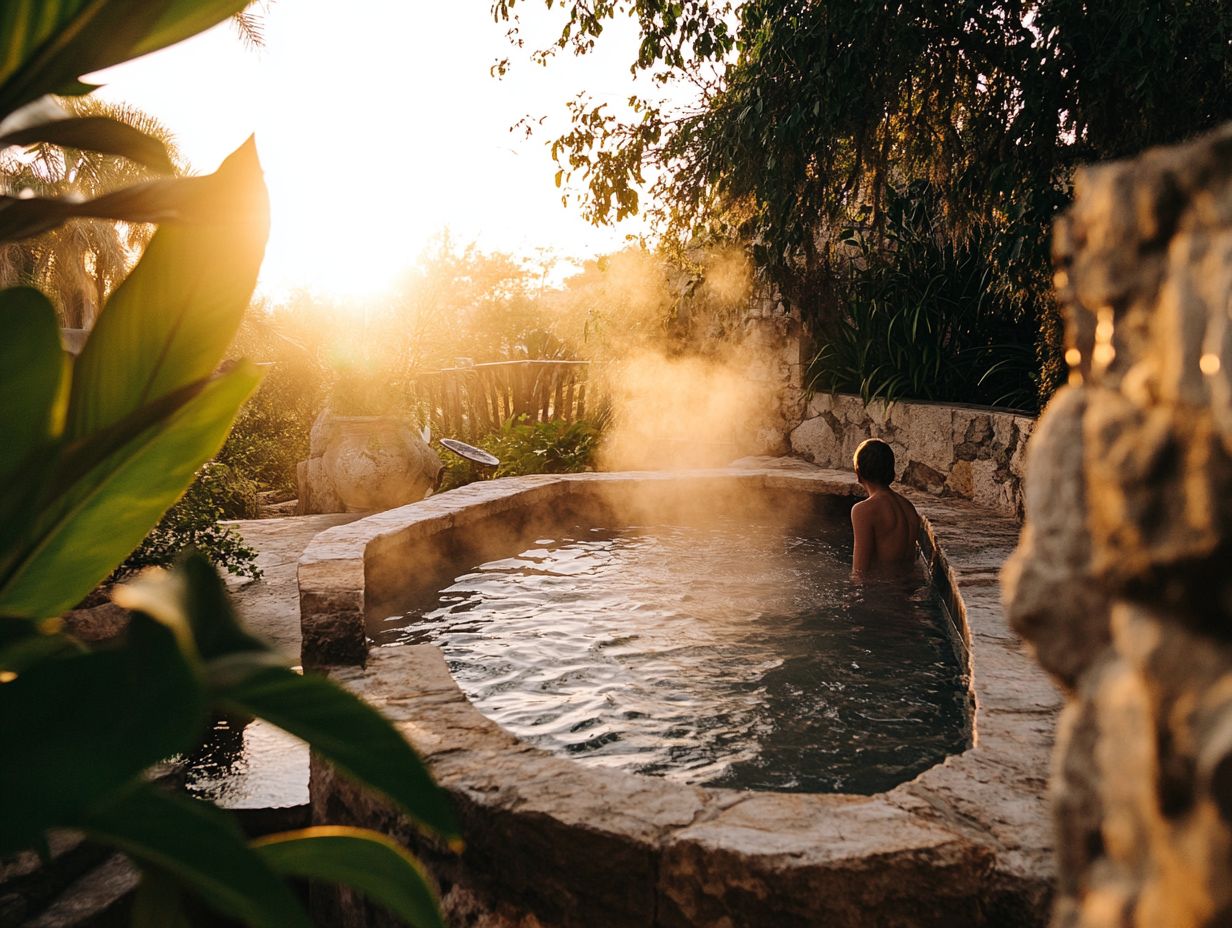Cold plunges are all the rage right now for their rejuvenating benefits and cold therapy, but you might be wondering about their safety and potential side effects. This article breaks down what a cold plunge is, how it works, and the amazing benefits it offers.
One common concern is whether cold plunging could make you feel dizzy or cause sensations of faintness. It’s important to understand the symptoms and potential triggers, especially if you’re thinking about giving this invigorating practice a try. We’ll share some tips on how to prevent dizziness and other side effects so you can have a safe and refreshing experience.
So, are you ready to dive into the world of cold plunges?
Contents
- 1 What Is a Cold Plunge and Cold Exposure?
- 2 How Does Cold Plunge Work?
- 3 What Is Dizziness?
- 4 What Are The Causes Of Dizziness?
- 5 How to Prevent Dizziness During a Cold Plunge?
- 6 What Are The Other Possible Side Effects Of Cold Plunges?
- 7 Frequently Asked Questions
- 7.1 Can cold plunge cause dizziness?
- 7.2 Why does a cold plunge cause dizziness?
- 7.3 Are there any other factors that can contribute to dizziness after a cold plunge?
- 7.4 How can I prevent dizziness after a cold plunge?
- 7.5 Is it safe to take a cold plunge if I have a history of dizziness or vertigo?
- 7.6 What should I do if I feel dizzy after a cold plunge?
What Is a Cold Plunge and Cold Exposure?

Cold plunge, often referred to as cold water immersion or cold exposure therapy, is all about submerging your body in cold water for a set amount of time. This technique has become quite popular in hydrotherapy because of its many therapeutic benefits, from helping with recovery to boosting your overall health and well-being.
Whether you’re an athlete aiming to elevate your performance or just someone looking for a way to relax, getting to know the ins and outs of cold plunging can really make a difference in your health journey, including post-exercise recovery. For an extensive analysis of this trend, our Ultimate Guide to Cold Plunge explores various aspects of cold water therapy and its health benefits.
How Does Cold Plunge Work?
Cold plunging works by getting your body into those chilly water temperatures, which kick-starts a whole bunch of physiological responses that affect your blood circulation, thermoregulation, and how your body regulates temperature.
When you take the plunge into cold water, your body goes into shock mode, leading to vasoconstriction and affecting your cardiovascular system. This helps optimize your cardiovascular response and manage thermal stress like a champ.
Not only does this technique help with muscle recovery and inflammation reduction (see also: Does cold plunge help with muscle recovery?), but it also boosts your overall physical endurance, mental resilience, and energy levels.
What Are the Benefits of Cold Plunging?
The benefits of taking a cold plunge are pretty impressive, affecting both your physical and mental health in a big way, including mental focus and alertness. This refreshing therapy not only helps reduce muscle soreness and improve circulation, but also flushes out toxins from your body, which is especially helpful after those intense workouts.
If you’re an athlete looking for quicker recovery, adding cold plunges to your fitness routine can really shorten your downtime, boost your performance, and enhance your recovery protocols. Plus, there’s something invigorating about diving into cold water that kicks your endorphin release into high gear. This can lead to a better mood and help ease symptoms of anxiety and depression, providing significant mental health benefits.
With its powerful combination of physical rejuvenation and mental uplift, cold plunging can be a game-changer for anyone wanting to optimize their health and well-being.
What Is Dizziness?
Dizziness is a catch-all term that describes a range of sensations, such as lightheadedness, fainting, vertigo, disorientation, and even nausea. It can feel pretty unsettling and can come from various sources, like inner ear problems or environmental stress. Understanding your dizziness is crucial because it can be linked to your mental health, autonomic nervous system, and overall well-being, affecting your daily life more than you might realize.
There are different types of dizziness, each tied to specific medical conditions. For example, vertigo gives you that spinning or movement feeling—definitely not the fun kind—and it’s often caused by issues with your inner ear’s vestibular system. Lightheadedness might hit you when you’re dehydrated or if your blood pressure suddenly drops. Additionally, let’s not forget about the dizziness that can arise during anxiety-filled moments.
Other underlying causes can include things like:
- Migraines.
- Certain medications.
- Anemia.
- Even cardiovascular issues.
By pinpointing what’s causing these sensations, you can manage your symptoms better and figure out the right treatment for you.
What Are The Causes Of Dizziness?
Dizziness can come from a bunch of different causes, some of which are pretty harmless while others might signal something more serious.
You might find that common culprits include dehydration, sudden shifts in your body position, or even environmental stressors like temperature changes.
It’s important to understand these triggers so you can get a handle on your own tolerance and manage any potential health risks tied to dizziness.
What Are the Possible Triggers of Dizziness?

Possible Triggers of Dizziness can vary widely for you and may include things like sensory overload, fluctuations in blood pressure, and anxiety. These triggers can hit you suddenly, leaving you feeling disoriented or unsteady. Recognizing what sets off these symptoms is key to developing effective prevention and management strategies.
Sensory overload happens when your brain gets bombarded with too much information from your senses, overwhelming its ability to process it all. Bright lights, loud noises, or even intense physical activity can contribute to this, leading to that dizziness you want to avoid.
On the flip side, anxiety can really amp up these sensations, which can be managed through relaxation techniques and mindfulness practices. When your body goes into fight-or-flight mode, it can trigger physical reactions that mimic dizziness, making everything feel even more complicated. Emotional stress can raise your heart rate and mess with your breathing patterns, cranking up the lightheadedness.
Understanding how these triggers connect can give you valuable insights for tackling those dizzy spells and help you regain a sense of balance in your daily life.
Can Cold Plunge Cause Dizziness?
Cold plunges can definitely make you feel dizzy, and that’s mainly because of your body’s cold shock response to those sudden temperature changes and the physiological effects that follow. When you jump into icy water, your body goes into overdrive, affecting blood circulation, heart rate variability, and how you generally feel. This can lead to lightheadedness or a vertigo-like sensation. It’s super important for you to be aware of these effects and to take the right safety precautions when diving into cold water.
As soon as you hit that cold water, your body kicks into gear with rapid breathing and an increased heart rate—this is known as the cold shock response, which affects your body’s thermoregulation. It’s your body’s way of trying to keep your core temperature steady, but it can also constrict your peripheral blood vessels, messing with blood flow and oxygen supply to those vital organs.
Because of this fluctuation in blood pressure, you might feel dizzy, which is why it’s crucial to ease into cold plunges gradually and build up your tolerance. Remember to keep safety in mind: make sure you’re in a controlled environment, have a buddy with you, and give your body enough time to adjust. That way, you can enjoy the invigorating experience without the unwanted side effects.
How to Prevent Dizziness During a Cold Plunge?
Preventing dizziness during a cold plunge is key to ensuring you have a safe and enjoyable experience while reaping all the health benefits. You can achieve this by acclimatizing properly and mastering your breath control, which promotes better body awareness and well-being.
Start by gradually exposing your body to colder temperatures to avoid cold intolerance, and don’t forget to practice some mindfulness techniques. This way, you can ease that shock response and keep your balance while soaking up all the therapeutic benefits of cold water immersion.
What Are The Precautions To Take Before Cold Plunge?
Before diving into a cold plunge, it is advisable to take safety precautions to make sure you’re ready and to keep any health risks at bay. Understanding your own tolerance to cold, checking for any underlying health issues, and setting up safety measures can help create a secure environment for your chilly adventure.
If you have any pre-existing conditions, like heart or respiratory issues, or if you’re pregnant, it’s vital to chat with a healthcare professional first. Starting off with shorter durations in cold water is a smart move; it’ll help you figure out your comfort level before you slowly increase the time you spend submerged, aiding in recovery time and acclimatization.
Having a buddy around is also a great idea—just in case any emergencies pop up. Additionally, stay hydrated, maintain electrolyte balance, and warm up properly afterward to avoid shock.
Being mindful of your surroundings and making sure the area is free from hazards can really enhance the safety of this invigorating practice.
How to Properly Do a Cold Plunge?
To properly perform a cold plunge, it’s essential to follow specific guidelines that ensure both effectiveness and safety to maximize recovery benefits. This means paying attention to how long you immerse yourself, understanding how your body reacts to cold temperatures, and gradually getting used to the experience to maximize those recovery benefits.
Start off slowly to get a feel for the sensation and your body’s physiological responses, which helps you adapt more comfortably and optimize your body temperature. If you’re new to cold exposure, it’s best to kick things off with shorter immersions of around 30 seconds to 1 minute, then gradually work your way up to a maximum of 3 to 5 minutes.
While you’re in there, keep an eye on your heart rate variability and breathing. Immersing yourself in cold water can be a shock to the system and may trigger that fight-or-flight response, but can lead to rejuvenation and an energy boost. When done right, this practice can enhance circulation, reduce muscle soreness, relieve muscle tension, and boost your overall wellness, making cold plunges a fantastic addition to your recovery routine.
What Are The Other Possible Side Effects Of Cold Plunges?

While the cold plunge offers a ton of health benefits, it’s important to keep an eye out for some potential side effects that might pop up along the way, such as claustrophobia. Related insight: it’s also worth exploring The Ultimate Guide to Cold Plunge to gain a deeper understanding of both benefits and safety measures.
You could experience skin irritation, hypothermia, nausea, or even some breathing difficulties, especially if you aren’t careful about safety precautions during your cold immersion therapy.
1. Skin Irritation
Skin irritation can happen during a cold plunge due to sudden temperature changes, also known as temperature shock, that mess with your skin’s temperature and sensitivity. You might notice some redness and discomfort, especially if you have sensitive skin.
When you suddenly dive into cold water, it can constrict your blood vessels and reduce circulation, which often leads to a tingling feeling that can escalate into irritation. This is a common body response to cold immersion. Not to mention, your skin’s natural barrier might get compromised, leaving it more vulnerable to environmental factors.
To keep discomfort at bay, it’s a good idea to gradually get your skin used to colder temperatures for a smoother transition, enhancing your tolerance build-up. Using protective barriers like skin oils or creams can also help lock in moisture and build resilience, contributing to stress relief.
Make sure to keep an eye on how long you’re exposed and listen to your body’s cues, adjusting as needed to make your cold plunge experience a lot more comfortable, potentially leading to mood enhancement.
2. Hypothermia
Hypothermia is a serious risk you need to watch out for when diving into a cold plunge, especially if you’re exposed to those frigid temperatures for too long during your cryotherapy sessions. Knowing the signs of hypothermia and taking some preventive steps can really help reduce this health risk and assist in your sport recovery.
While you’re enjoying your cold plunge, the temperature can cause your body’s core temperature to drop quickly, making it more likely for you to experience symptoms like shivering, confusion, or even loss of consciousness due to adrenaline release. This happens because your body is trying to keep itself warm in those icy conditions. That’s why it’s crucial for you to stay aware of your surroundings and know your own limits.
To protect yourself, make sure you acclimatize properly to the cold water, wear the right thermal gear when needed, and limit how long you stay submerged as part of your wellness practices.
Being mindful of warning signs—like any physical discomfort or unusual behavior—can really help you avoid any negative health effects during your chilly adventures.
3. Nausea
Nausea can be concerning when you dive into a cold plunge, and it usually comes from your body’s reaction to that sudden cold exposure and quick temperature changes, often related to cold-induced thermogenesis. Understanding how cold immersion and nausea are linked can really help you manage your experience better.
When you jump into cold water, your body goes through a series of physiological responses that can lead to blood vessels constricting and your heart rate speeding up, which can sometimes leave you feeling dizzy or a bit nauseous. If you’re not used to sudden temperature changes or have any underlying health issues, this reaction can be even stronger, especially if you have low blood pressure.
To alleviate discomfort, it’s a good idea to gradually acclimate to colder temperatures. You can also try some consistent deep breathing techniques while you’re in the plunge. Staying hydrated and keeping an eye on how your body is reacting can make a big difference in preventing discomfort, ensuring circulation improvement.
After all, you want to fully enjoy those refreshing benefits of cold immersion!
4. Breathing Difficulties
If you experience breathing difficulties after immersion, it is important to stay calm and slowly try to take deep breaths. If symptoms persist, it’s advisable to exit the water and seek fresh air. Monitor your body’s reactions closely, and if you feel dizzy or faint, sit down and rest until you feel stable. Always consult with a healthcare professional if you have concerns or if the symptoms do not improve.
You might find that breathing difficulties pop up during a cold plunge, thanks to your body’s cold shock response, which can affect your fitness routines. This can lead to hyperventilation and an increased heart rate, so it’s important to recognize this physiological effect to manage your experience safely and enjoy the benefits of alternative therapies.
When you jump into cold water, your body reacts instinctively, triggering all sorts of changes like constricting blood vessels and pumping out adrenaline. This response can throw you into a bit of a panic, making it tough to breathe steadily.
To tackle these challenges, you can try techniques like deep diaphragmatic breathing or the Buteyko method, which are effective breathing techniques. These focus on slow, controlled breaths, which not only help calm down hyperventilation but also promote relaxation, making your cold plunge a much more comfortable experience, leading to a meditative state.
Frequently Asked Questions

Can cold plunge cause dizziness?
Yes, in some cases, a cold plunge can shock your body. This is because the sudden change in temperature can affect your balance and make you feel lightheaded.
Why does a cold plunge cause dizziness?
A cold plunge can cause dizziness due to the sudden drop in body temperature, a common result of cold exposure. This can cause a decrease in blood pressure and lower blood flow to the brain, leading to feelings of lightheadedness and dizziness, often experienced during ice baths.
Are there any other factors that can contribute to dizziness after a cold plunge?
Yes, individuals who have low blood pressure or circulation problems may be more prone to dizziness after a cold plunge. Additionally, staying in the cold water for too long or not properly acclimating to the temperature can also increase the likelihood of dizziness.
How can I prevent dizziness after a cold plunge?
To prevent dizziness after a cold plunge, it is important to properly acclimate your body to the cold water. This can be done by slowly entering the water and not staying in for too long. You can also try splashing cold water on your face and neck before entering the cold plunge to help invigorate your senses, which can help invigorate your senses.
Is it safe to take a cold plunge if I have a history of dizziness or vertigo?
If you have a history of dizziness or vertigo, consulting your doctor is important before taking a cold plunge, especially if you are new to wellness trends. They can advise you on whether or not it is safe for you and provide any necessary precautions.
What should I do if I feel dizzy after a cold plunge?
If you feel dizzy after a cold plunge, it is important to get out of the water and slowly warm up your body, initiating a proper warm-up. Sit or lie down, and drink some water to help regulate your blood pressure. If the dizziness persists, seek medical advice.
This website may contain affiliate links. As an affiliate, we may earn a commission from qualifying purchases at no additional cost to you.

